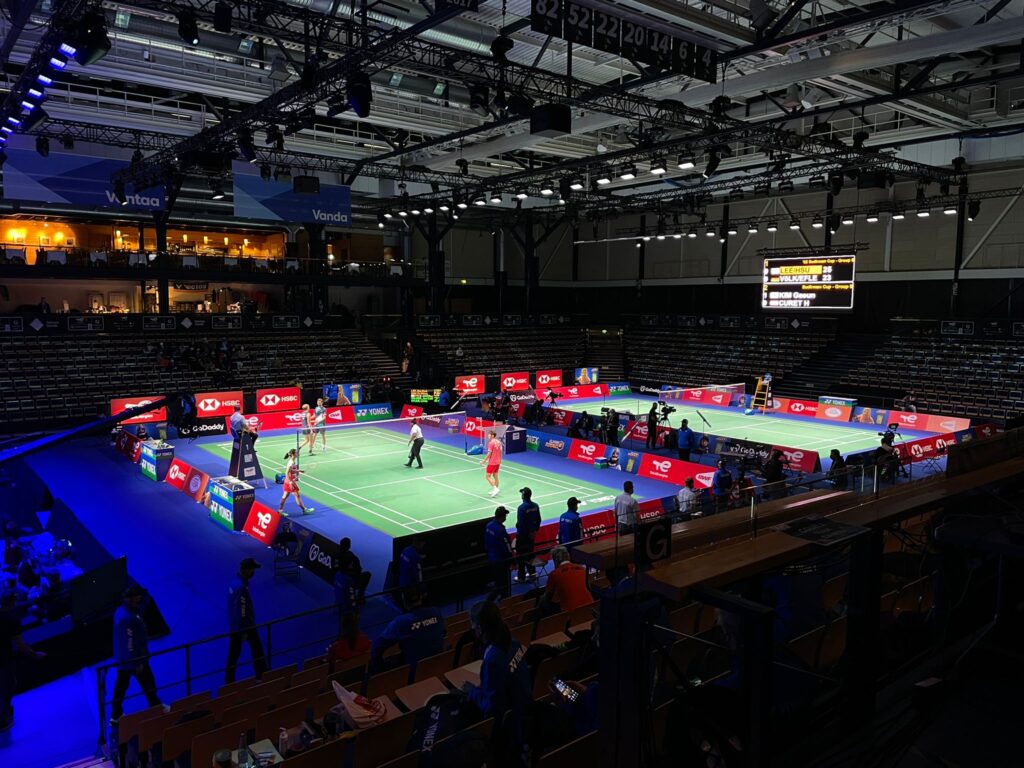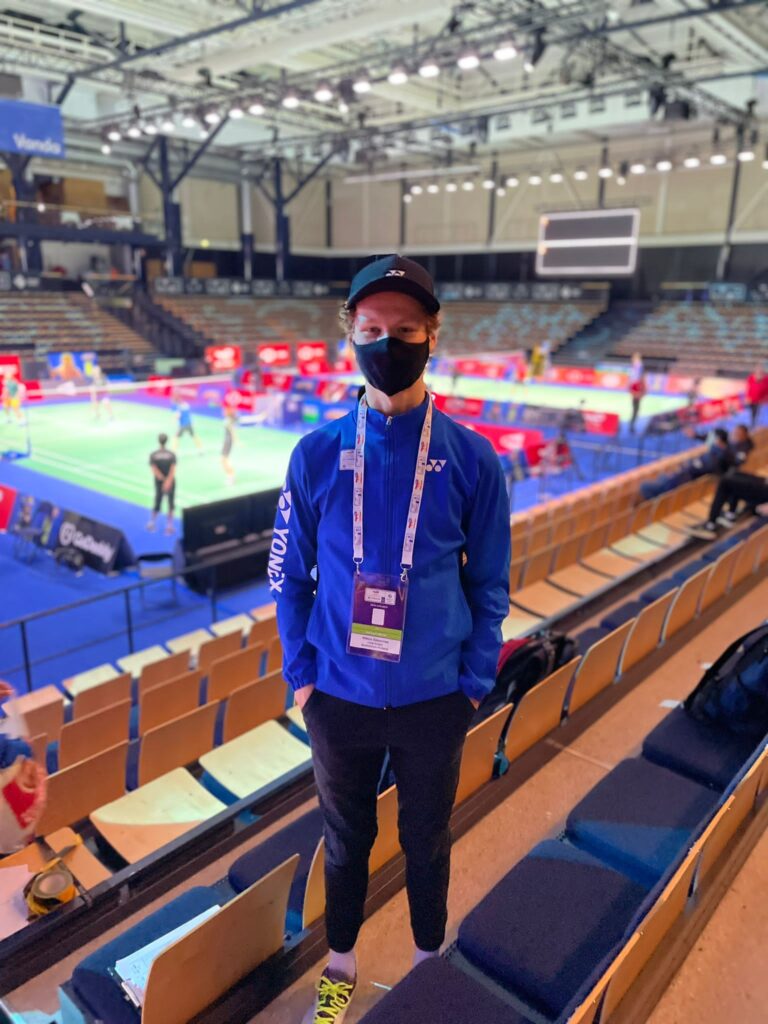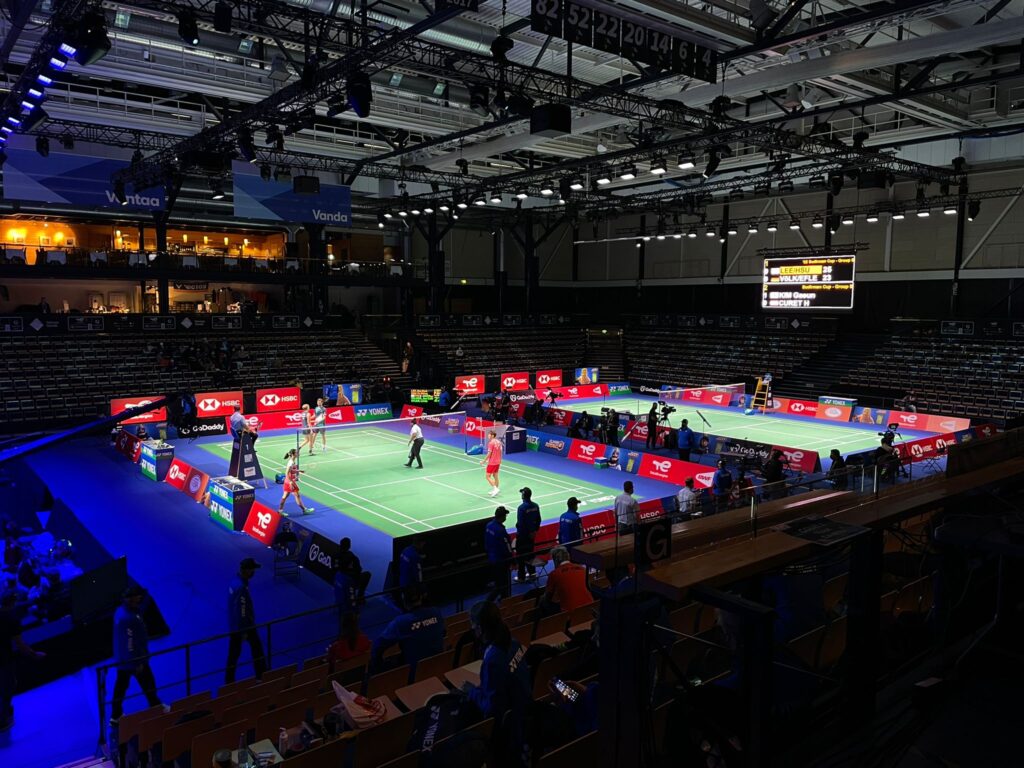Menu
Viime viikolla Suomessa kisattiin historiallisesti sulkapallon joukkueiden maailmanmestaruudesta, eli Sudirman Cupista. Paikalla oli suuri osa lajimme absoluuttisesta maailman kärjestä ja sunnuntaina pokaalin pääsikin nostamaan 12. kerran useammankin tuoreen olympiamitalistin tähdittämä Kiinan joukkue. Nyt pääsemme palaamaan kisan tunnelmiin hieman eri näkökulmasta, nimittäin Mikko oli kilpailussa mukana vapaaehtoisena linjatuomarina, ja raportoi tunnelmiaan ja kokemuksiaan viikon varrelta. Mikko on kokenut kisa-avustaja: hän on ollut seuramme kilpailuissa kuuluttajana, pisteen näyttäjänä, toimitsijapöydällä hommissa, palkintojen jakajana yms. Kokemusta linjatuomaroinnistakin oli valmiiksi jo Tapion Sulan eliitistä, SM-kisoista sekä Finnish Openista, mutta MM-tason kisoissa oltiin silti uuden äärellä.

"Rajatuomarointi Sudirman Cup:issa oli monilla tavoin hyvin samankaltaista kuin mitä se on ollut SM-kisoissa tai Finnish Open:eissa. Rajatuomarin tehtävänä on toimia toisena parina silmiä ottelun tuomarille ja vahtia mihin kohti kenttää pallo putoaa omaan vahdittavaan rajaan nähden. Kuitenkin kokonaisuutena Sudirman Cup oli hyvin erilainen kokemus. Panokset olivat erittäin korkealla, ja luonnollisesti vastuu oli myös suuri.
Kilpailujen arvokkuus ilmeni jo ensimmäisissä ohjeissa, mitä sain briefingin aikana: rajatuomareiden on istuttava kädet polvien päällä, jalat lantion leveydellä, selkä suorana, ryhdikkäästi ja siististi. Rajatuomareiden tulee kävellä paikalle jonossa tasaisin välimatkoin, istuutua ja nousta ylös yhtäaikaa, lähteä kävelemään pois kentältä juuri silloin, kun tuomarin jalka ensimmäiseksi koskettaa kenttää, ja odottaa oikeassa paikassa. Vaikkakin rajatuomioiden näyttö oli meidän päähuomiomme, suuri osa meidän tehtäväämme oli myös näyttää mahdollisimman hyvältä (sekä näkyä mahdollisimman vähän) televisiossa. Vaikka kävelyohjeet eivät olleet täysin uudet verrattuna esimerkiksi Finnish Open -kisoihin, niitä painotettiin entistäkin enemmän ja ne olivat alusta loppuun asti koreografioidut.
Kisoja muutti myös se, että rajatuomioita tukemassa oli Hawkeye, eli kameroiden avulla toimiva tarkistusväline, jolla pystyttiin tarkistamaan haastetut tai epäselvät tuomiot. Hawkeye toi myös tietynlaisen ylimääräisen paineen kisoihin: jos näit väärin ja rajatuomio haastettiin, kaikki saisivat tietää.
Toimin rajatuomarina kymmenessä eri ottelussa. Olin äärimmäisen onnekas saadessani näyttää rajaa monille sulkapallon parhaimmille pelaajille. Näihin kuuluivat mm. miesten kaksinpelistä Anders Antonsen (ranking 3), Chou Tien Chen (ranking 4) ja Anthony Ginting (ranking 5), naisten kaksinpelistä An Seyoung (ranking 8), miesten nelinpelistä Marcus Gideon ja Kevin Sukamuljo (ranking 1) sekä Aaron Chia ja Son Wooi Yik (ranking 8 ja Tokion pronssimitalistit), naisten nelinpelistä Chloe Birch ja Lauren Smith (ranking 13), ja sekanelinpelistä Praveen Jordan ja Melati Oktavianti (ranking 4). Ensimmäinen hetki, jona todella näin tähtiä oli kun huomasin istuessani jo valmiina omalla rajallani odotellessa pelaajien saapumista, että Chou Tien Chen tulisi pelaamaan siinä nimenomaisessa pelissä. Loppuviikko menikin sitten tähtiä nähdessä.
Ennen turnauksen alkamista odotin innolla sitä, kun pelaajat haastavat rajatuomioita. Oletin näkeväni omalta tuoliltani niin selkeästi oman vahdittavan rajani, ettei kukaan pääsisi yllättämään. Kuitenkin näytettyäni väärin yhden tuomion sekä Anders Antonsenin että An Seyoungin peleissä, tajusin rajatuomaroinnin olevan vielä vaativampaa kuin aiemmin olin kuvitellut. Vaikeaa on myös olla antamatta väärien tuomioiden vaikuttaa omaan asenteeseen tai suoriutumiseen seuraavassa pallossa ja seuraavissa peleissä.
Itselleni An Seyoungin pelissä näytetty virheellinen tuomio tuntui jopa nöyryyttävältä, ja olinkin jo ehtinyt manata itseni historian huonoimmaksi rajatuomariksi ennen kun myöhemmin samana päivänä kyseisen pelin latvialainen päätuomari kertoi itsekin nähneensä pallon laskeutuvan rajalle eikä rajan ulkopuolelle. Jos ottelun BWF:n kouluttama päätuomarikin oli nähnyt pallon laskeutuvan sisälle, kun se oli todellisuudessa ollut ulkona, ehkä minäkin saan tehdä virheitä. Onneksi kisoissa oli Hawkeye varmistamassa, että oikeus tapahtuu.
Rajatuomaroinnissa ei ole järkevää tuijottaa omaa rajaa koko pelin ajan odottaen, että pallo jossain vaiheessa laskeutuu rajan tuntumaan, vaan palloa kannattaa seurata, ja olla aina valmis siihen, että se lyödään omalle rajalle. Pääsin siis toisin sanoen seuraamaan maailman parasta sulkapalloa muutaman metrin etäisyydeltä. Kaikki kymmenen peliä, joissa olin rajalla, olivat huikean hienoa katsottavaa. Itselleni mieleen jäi erityisesti Anders Antonsenin ja Anthony Gintingin miesten kaksinpeli, sekä Taipein ja Korean välinen naisten nelinpeli. Antonsenin pelissä oli lukuisia tilanteita, joissa olin varma, että Ginting saisi pisteen ja että pallo laskeutuisi kenttään, tai vähintään, että jos Antonsen saisi pallon palautettua, piste olisi menetetty muulla tavoin. Aina Antonsen sai kuitenkin haettua pallon ja käännettyä pisteen omaksi hyväkseen. Muistan, kuinka hämmentynyt ja ihmeissäni olin siitä, miten vaikeista paikoista hän onnistui pallon hakemaan. Taipein ja Korean välisessä nelinpelissä Kong, Lee ja Chang ja Lee taasen pelasivat hyvin aggressiivista ja näyttävää peliä, jossa lyötiin paljon smasheja ja pelattiin todella nopealla tempolla. Mieleeni jäi erityisesti yksi kolme lyöntiä pitkä pallo, jossa Lee Sohee vastaanotti swip-syötön, jota hän ei ollenkaan osannut odottaa. Hän oli aivan pulassa, ja kurotti pallon aivan kentänrajasta rystyltä, ja sai sen palautettua verkon yli. Vaikka pallo hipoikin verkkoa, vastustaja oli asemissa ja sai tapettua pallon kenttään. Lee ja Kong olivat pettyneitä huonoon suoritukseen, kun taas minä olin ällistynyt kuinka hienolla lyönnillä Lee sai pallon palautettua.
Muita mieleenpainuvia hetkiä kisoissa oli muunmuassa lounastauko erään BWF:n virallisen rajatuomarin kanssa. Hän on kouluttautunut rajatuomariksi ja kiertää BWF:n isoja kisoja muutamia kertoja vuodessa. Hän oli muunmuassa päässyt rajalle olympialaisissa. Vaatii omistautumista ja rakkautta lajiin, että jaksaa jättää kotinsa (ja hänen tapauksessaan pienen lapsensa) useamman kerran vuodessa lähteäkseen istumaan sulkapallohallille jopa kaksitoistatuntisten päivien ajaksi. Kuulin myös eräästä vapaaehtoisesta, joka maksaa itse omat lentonsa ja majoittumisensa, jotta pääsee rajatuomariksi. Itse vielä kehtasin välillä jopa valittaa kun piti herätä seitsemältä. Toinen mieleenpainuva hetki oli harjoituskentiltä, joiden vieressä odottelimme pääsyä kentälle. Korean joukkue harjoitteli sekanelinpeliä, ja pääsimme katsomaan sitä kirjaimellisesti metrin etäisyydeltä. Silloin ei edes tarvinnut keskittyä omaan rajaan, vaan sai nauttia hetken aikaa aivan uskomattoman hienosta harjoituspelistä.
Sudirman Cup oli ainutlaatuinen kokemus, joka sai minut kunnioittamaan isojen kisojen rajatuomareita aivan uudella tavalla. Seitsemältä herääminen aamuisin oli täysin sen arvoista, kun pääsi seuraamaan huippusulkapalloa lähempää kuin kukaan maksavista myöhemmin heräävistä katsojista!"

Last week a historic badminton event was held in Finland as the Sudirman Cup (world mixed team championship) was played in Vantaa. We had most of badminton's biggest stars here in Finland and for example the winning team China had more than one Tokyo olympic medalist in their team. Now we get to hear what the experience was like seen from the line judge's bench as Mikko was helping in the competition as a volunteer. Mikko has experience from all kinds of technical official duties, like announcer, showing points, giving medals etc. He has also been a line judge before in Tapion Sulka's elite competition, Finnish nationals and Finnish Open, but the world championship was still a new experience.

"Line judging at the Sudirman Cup was in many ways similar to what it was like at the Finnish Championships or the Finnish Open. The line judge’s job is to act as another pair of eyes for the umpire and monitor where the shuttle lands in relation to the line they are responsible for. However, the experience of line judging at the Sudirman Cup as a whole was quite different. The stakes were high, and naturally there was a lot of responsibility to do ones job well.
The prestige of the tournament was apparent already in the first instructions I was given in my first briefing: line judges were to sit with their hands on their knees, feet planted firmly on the ground at your hips width, back straight. Line judges should also arrive on court with even spacings, sit down and get up at the same time, leave the court in the right order, and start walking when the umpires foot first touches the ground, waiting in the right place. Although our main focus was our job as technical officials, ensuring that we see where the shuttle lands and reporting it loud and clear, it was also very important for us to look as good as possible (and to be seen as little as possible) on television. Although instructions on how to walk on court weren’t completely new compared to the Finnish Open for example, they were emphasised more than before and were choreographed in detail from start to finish.
The competition was also set apart by the fact that the Hawkeye monitoring system was implemented to check unseen calls or challenged calls. Hawkeye also brought an extra pressure for the line judges: if you had miscalled and your call had been challenged, everyone would know.
I line judged in ten different matches. I was extremely lucky to be a technical official for some fo the best badminton players in the world. This included Anders Antonsen (ranking 3), Chou Tien Chen (ranking 4) and Anthony Ginting (ranking 5) from men’s singles, An Seyoung (ranking 8) from women’s singles, Marcus Gideon and Kevin Sukamuljo (ranking 1) and Aaron Chia and Son Wooi Yik (ranking 8 and bronze medalists from Tokyo) in mens doubles, Chloe Birch and Lauren Smith (ranking 13) in women’s doubles, and Praveen Jordan and Melati Oktavianti (ranking 4) in mixed doubles. The first starstruck moment I had was when I was waiting on court for the players to arrive for a men’s singles match, and I looked at the screen only to see that Chou Tien Chen would be playing in that game. The rest of the week I would get to see even more stars.
Before the tournament I was excited about getting challenged by players. I assumed that I would have such a clear view of my own line that any challenges I would get would be unsuccessful. After making one incorrect call in Anders Antonsen’s and An Seyoung’s matches, I realised line judging was even more challenging than I thought. It was also hard to not let the incorrect calls affect your attitude or performance in the next rally and the next matches.
For me the incorrect call shown in An Seyoungs game felt quite humiliating, and I had already deemed myself the worst line judge in the history of badminton before the Latvian umpire in that particular game told me he also saw the shuttle landing in, as I had. If a BWF trained umpire can make a mistake, perhaps I can too. Luckily Hawkeye made sure that incorrect calls could be corrected.
It’s not optimal to stare at one’s own line for the whole match waiting for the shuttle to land near it, but it’s better to follow the rally while always keeping in mind that the shuttle can at any moment land near your line. In other words, I got to follow some of the best badminton in the world at few meters distance. All ten games that I line judged in were incredible to watch. The most memorable for me were Anders Antonsen’s and Anthony Ginting’s mens singles match, and the women’s doubles match between Chinese Taipei and Korea. Antonsen’s match had innumerous situations where I was confident that Ginting would get a point and the shuttle would land on Antonsen’s side of the court. However, Antonsen each time managed to return the shuttle, and not only that, he would return it beatifully and in a way where Ginting wasn’t able to keep control of the rally. I remember how confused and impressed I was with how well he could return the shuttle from incredibly difficult positions. In the doubles between Chinese Taipei and Korea, Kong, Lee, and Chand and Lee played aggressive and entertaining badminton with lots of smashes and a very high tempo. I remember especially a rally that only lasted three shots: Lee Sohee received a swip that she wasn’t prepared for, she lunged as far as she could to the back of the court, and managed to return the shuttle over the net with a backhand hit from right above the court. Though the return was quite good, it was just high enough for the Taiwanese to kill the shot into the court. Lee and Kong were disappointed in their bad performance whereas I was gobsmacked with the shot Lee had hit.
Other memorable moments in the tournament included my lunch break on Monday where I ate with a BWF official line judge. She had been trained to be a line judge and she goes around the world volunteering in the big tournaments, including the 2021 Tokyo Olympics. It requires dedication and passio for the sport to leave ones home (and in her case her small child) several times a year to go sit in a badminton hall for several 12 hour days. I even heard of a volunteer who pays for their own flights and accommodation to be able to line judge. To think that I complained about waking up at seven to go line judge! Another memorable moment was when we were waiting to go on court next to the warm-up courts, and the Korean team was playing mixed doubles amongst themselves, just as practice. They played incredibly well, and we got to watch from literally a meters distance. We didn’t have to focus on a line either, but we just got to enjoy.
Sudirman Cup was an incomparable experience that made me respect line judges even more than before. Waking up at seven was completely worth it, as I got to watch the worlds best players from much closer than the audience that had payed for their tickets!"


